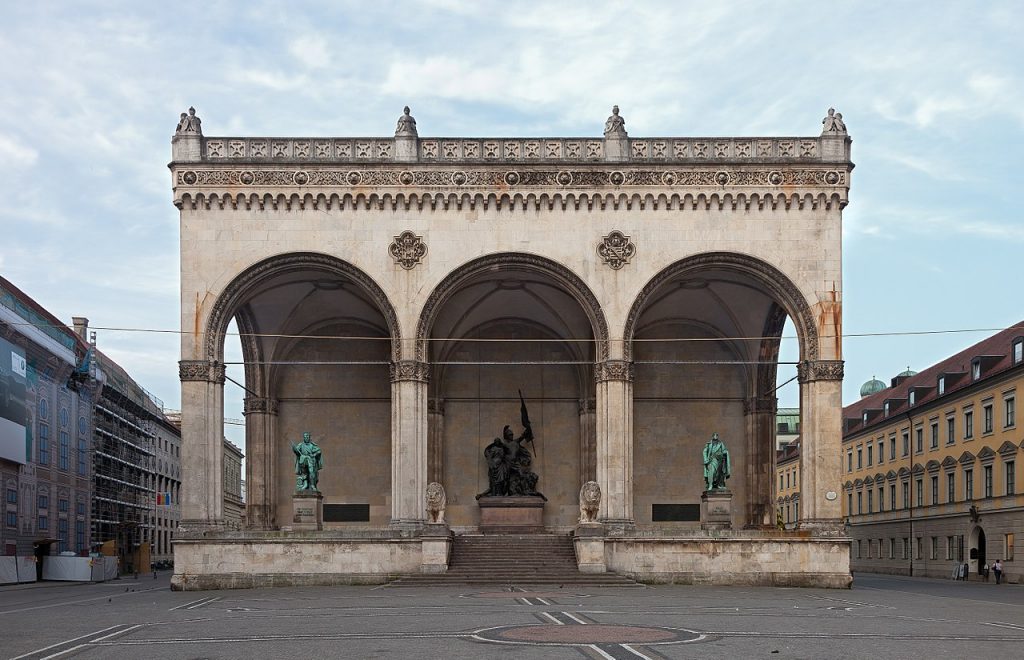The German Memorial In Viscardigasse Posted by Constanze on Jun 3, 2020 in Culture
There is a little street in Munich that is home to a subtle memorial with a very powerful history attached to it. In this post I’d like to share with you the memorial in Viscardigasse, Munich, and the meaning behind it.
History
To understand the memorial that is there today, we must first look at a different memorial that existed during Hitler’s reign.
In November of 1923, Hitler famously attempted to overthrow the Weimar Republic in what became known as The Beer Hall Putsch. Sixteen Nazis died during it, which prompted Hitler to erect a memorial (das Mahnmal) for them once he eventually came into power. This memorial was situated outside the Feldherrnhalle, the building where the Beer Hall Putsch took place. It was called Mahnmal der Bewegung – ‘the memorial for the movement’.
This memorial was guarded by SS soldiers, and anyone who passed by it was required to give the Hitlergruß (Nazi salute).
Many did not want to salute the memorial, but did it out of die Angst (fear). However, others found a way to avoid it completely.
There was a little street nearby called Viscardigasse. By walking down this street, people found they could avoid walking past the memorial altogether. Due to it being used in this way, Viscardigasse came to be known as Drückebergergasse, a word roughly translating to ‘shirker’s alley’ or ‘deserter’s alley’.
It may not seem a big deal to walk down a different street, but if you bear in mind that there were grave consequences for anyone who was suspected to be defying the Nazis, and that it would have been much safer to walk past the memorial and give the salute, even if they didn’t want to, the people who actively avoided doing so were taking a big risk.
Today
In 1995, the city commissioned a memorial in Viscardigasse to commemorate the Germans who refused to salute the Mahnmal der Bewegung. This memorial consists of a trail of bronze tiles running along the ground, and symbolises where those Germans walked to quietly state their defiance of Nazi rule. It is a very subtle memorial for a very subtle, yet powerful, act.
If you wanted to visit the Feldherrnhalle and Viscardigasse, the closest Munich U-Bahn (underground) stop you should get off at is Odeonsplatz. There is a sign containing information about Viscardigasse, underneath its street sign.
Hopefully you enjoyed learning about Viscardigasse, and can see it for yourself one day, too. 🙂
Bis bald (see you soon)!

Build vocabulary, practice pronunciation, and more with Transparent Language Online. Available anytime, anywhere, on any device.








Comments:
Rodney Apfelbeck:
Very interesting bit of history. Thanks!
Constanze:
@Rodney Apfelbeck Glad you enjoyed the post, Rodney!
Art Rutherford:
Very interesting. Thank you. I’m a WWII and history buff and found this information to be good.
Constanze:
@Art Rutherford Glad you liked it, Art!
Angela Daly:
What a fantastic bit of historic trivia!!! Thank you for this post! I wish I knew about it when I was in Munich, but there’s always another time.
Constanze:
@Angela Daly Yes, definitely! I found out about it on a website about ‘hidden Munich’. I think it’s one of the less-obvious tourist attractions over there, but for me, that makes it more exciting.
Clive Greenwood:
A few years ago we walked past this building on our way to a small Christmas market, and wondered what is was.
Now I know.
Many thanks.
Constanze:
@Clive Greenwood You’re welcome! 🙂